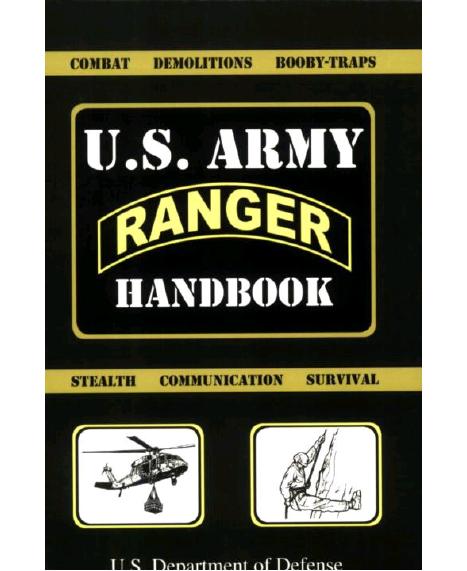U.S. Army Ranger Handbook by U.S. Department of Defense

Author:U.S. Department of Defense
Language: eng
Format: mobi, epub, pdf
Published: 2008-09-21T07:53:00+00:00
Figure 5-10. Patrol Base
5-6. MOVEMENT TO CONTACT
a. Purpose/General: The movement to contact (MTC) is one of the five types of offensive operations. A MTC gains or regains contact with the enemy. Once contact is made, the unit develops the situation. Normally a platoon conducts a MTC as part of a larger force. There are two techniques of conducting a movement to contact: Approach march and search & attack.
(1) Search and Attack (S&A). This technique is utilized when the enemy is dispersed, is expected to avoid contact, disengage or withdraw, or you have to deny his movement in an area. The search and attack technique involves the use of multiple platoons, squads, and fire teams coordinating their actions to make contact with the enemy. Platoons typically attempt to find the enemy and then fix and finish him. They combine patrolling techniques with the requirement to conduct hasty or deliberate attacks once the enemy has been found. Planning considerations include:
• The factors of METT-TC.
• The requirement for decentralized execution.
• The requirement for mutual support.
• The length of operations.
• Minimize soldier's load to facilitate stealth and speed.
• Resupply and MEDEVAC.
• Positioning key leaders and equipment.
• Employment of key weapons.
• Requirement for patrol bases.
• Concept for entering the zone of action.
• The concept for link-ups while in contact.
(2) Approach March. The concept of the approach march is to makecontact with the smallest element, allowing the commander the flexibility of destroying or bypassing the enemy. A platoon uses the approach march method as part of a larger unit. It can be tasked as the advance guard, move as part of the main body, or provide flank or rear security for the company or battalion. They may also receive on-order missions as part of the main body.
b. Fundamentals common to all movements to contact.
(1) Make enemy contact with smallest element possible.
(2) Rapidly develop combat power upon enemy contact.
(3) Provide all-round security for the unit.
(4) Support higher unit's concept.
(5) Reports all information rapidly and accurately and strives to gain and maintain contact with the enemy.
(6) Requires decentralized execution.
(7) The following issues should be considered heavily for MTC operations: (a) Factors of METT-TC.
(b) Reduced soldier's load.
c. Task Standards. The platoon moves NLT the time specified in the order. The platoon makes contact with the smallest element possible, and the main body is not surprised by the enemy. Once the platoon makes contact, it maintains contact. The platoon destroys squad and smaller-sized elements, and fixes elements larger than a squad. The platoon maintains sufficient fighting force capable of conducting further combat operations. Reports of enemy locations and contact are forwarded. If not detected by the enemy, the PL initiates a hasty attack. The platoon sustains no casualties from friendly fire. The platoon is prepared to initiate further movement within 25 minutes of contact, and all personnel and equipment are accounted for.
d. Critical Performance Measures (Search and Attack).
(1) The platoon locates the enemy without being detected.
(2) Once engaged, fixes the enemy in position and maneuvers against the enemy.
(3) Maintains security throughout actions to avoid being flanked.
Download
U.S. Army Ranger Handbook by U.S. Department of Defense.epub
U.S. Army Ranger Handbook by U.S. Department of Defense.pdf
This site does not store any files on its server. We only index and link to content provided by other sites. Please contact the content providers to delete copyright contents if any and email us, we'll remove relevant links or contents immediately.
| Automotive | Engineering |
| Transportation |
Whiskies Galore by Ian Buxton(41716)
Introduction to Aircraft Design (Cambridge Aerospace Series) by John P. Fielding(33014)
Small Unmanned Fixed-wing Aircraft Design by Andrew J. Keane Andras Sobester James P. Scanlan & András Sóbester & James P. Scanlan(32683)
Craft Beer for the Homebrewer by Michael Agnew(18079)
Turbulence by E. J. Noyes(7891)
The Complete Stick Figure Physics Tutorials by Allen Sarah(7261)
Kaplan MCAT General Chemistry Review by Kaplan(6818)
The Thirst by Nesbo Jo(6752)
Bad Blood by John Carreyrou(6472)
Modelling of Convective Heat and Mass Transfer in Rotating Flows by Igor V. Shevchuk(6352)
Learning SQL by Alan Beaulieu(6157)
Weapons of Math Destruction by Cathy O'Neil(6080)
Man-made Catastrophes and Risk Information Concealment by Dmitry Chernov & Didier Sornette(5874)
Digital Minimalism by Cal Newport;(5582)
Life 3.0: Being Human in the Age of Artificial Intelligence by Tegmark Max(5402)
iGen by Jean M. Twenge(5320)
Secrets of Antigravity Propulsion: Tesla, UFOs, and Classified Aerospace Technology by Ph.D. Paul A. Laviolette(5235)
Design of Trajectory Optimization Approach for Space Maneuver Vehicle Skip Entry Problems by Runqi Chai & Al Savvaris & Antonios Tsourdos & Senchun Chai(4953)
Electronic Devices & Circuits by Jacob Millman & Christos C. Halkias(4861)
